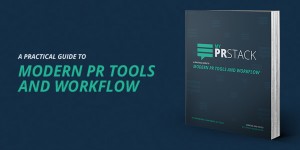My #PRStack: A practical guide to PR tools and workflow

About the author
Richard Bailey Hon FCIPR is editor of PR Academy's PR Place Insights. He teaches and assesses undergraduate, postgraduate and professional students.

Can you tell your Prezly from your Feedly? Your Topsy from your Moz? What’s the purpose of Sprout Social or Lissted?
To say why you need to know, let’s take a step back to the bad old days of public relations. The media relations workflow may not have been that simple: it took technique, but it did not rely on many tools or technologies.
Well-known publicist Mark Borkowski explains it with his customary flair in an Instagram caption: ‘what matters to us is contacts, culture, energy, creativity, bullshit and bollocks. And of course, our last piece of coverage.’
Beyond bullshit
The last piece of coverage may still preoccupy some PR practitioners, but many have come to realise that a Google search ranking is more important to their company or client than any amount of positive media coverage. Or, put another way, media relations may simply be one tool in the PR toolkit. So what are the others? How can PR practitioners keep up with technology and defend their territory from SEO specialists or content marketers?
This is why you need to know about My #PRStack. It’s the latest crowdsourced ebook inspired by a public plea from the energetic Stephen Waddington. A team of 18 expert contributors have produced an 84 page free ebook explaining over 40 tools useful to practitioners.
The contributions are arranged into six sections covering listening and planning, content, curation, building relationships, example workflows, and project management.
I had thought to focus this review on a new tool introduced by a trusted ‘old’ adviser. There’s Stuart Bruce introducing Flipboard; or Scott Guthrie on Circloscope; and Andrew Smith on Buzzsumo, Feedly, Sniply and Buffer. There are just too many new tools, and too many old advisers here!
Of geeks and Google
Since many practitioners may feel paralysed by the choice and novelty, let me focus on one tool that will resonate with traditional PR practice. Hemingway is described by Sarah Hall – and also recommended by David Sawyer. Inspired by Ernest Hemingway’s muscular prose, it’s an app that advises when to shorten sentences – and guides on the use of verbs and the active voice. It provides a readability grade to encourage simple, effective writing that communicates.
Unlike many tools in this collection, you have to pay for Hemingway. It costs $8.38 – little more than £5.
Writing in the style of a dead author is one thing. Keeping up with Google’s guidelines is another. This book will guide you on campaign keywords and on when to use ‘no follow’ links.
My one quibble is that some of the chapters are less well written than others (I won’t name and shame). It’s what happens when you crowdsource contributions from volunteers. It’s why you sometimes need a flesh-and-blood human as copy editor.
Perhaps it’s also what happens when the data geeks with their digital dashboards take over the PR show. Some of the old-style showmanship is lost.
It’s a geekier world than that of the spinners of stories and hewers of headlines.
But there’s also less bullshit and bollocks. It’s the future of PR rather than its past.